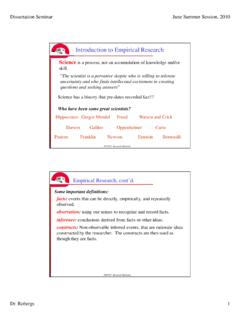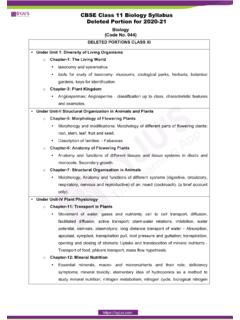Transcription of Running Head: THREE ORGANIZATIONAL LEARNING …
1 Running Head: THREE ORGANIZATIONAL LEARNING THEORIES 1 A comparative Analysis of THREE Unique Theories of ORGANIZATIONAL LEARNING Carol C. Leavitt Author Contact Information: 1131 Mesa Vista Drive Ivins, UT 84738 Telephone: (435) 773-7337 Email: Publication Date: September 14, 2011 THREE ORGANIZATIONAL LEARNING THEORIES 2 Abstract The purpose of this paper is to present THREE classical theories on ORGANIZATIONAL LEARNING and conduct a comparative analysis that highlights their strengths, similarities, and differences. Two of the theories experiential LEARNING theory and adaptive & generative LEARNING theory represent the thinking of the cognitive perspective, while the third theory assimilation theory coincides with the behavioral school of thought on ORGANIZATIONAL LEARNING .
2 The THREE criteria to be used in the comparative analysis include: 1) the LEARNING process, or how LEARNING occurs in each theory; 2) the LEARNING target, or who experiences the LEARNING ; and 3) the LEARNING context, or the antecedents and conditions that promote a LEARNING organization. Because theory building in this discipline has a history of approaches that fragment rather than assimilate new theory (L hteenm ki, Toivonen, & Mattila, 2001, p. 113), a new prototype theory will be introduced that effectively integrates the important themes, principles, and practices of ORGANIZATIONAL LEARNING into a more holistic model. THREE ORGANIZATIONAL LEARNING THEORIES 3 Table of Contents Abstract .. 2 Introduction to ORGANIZATIONAL LEARNING Theory.
3 4 Definitions of ORGANIZATIONAL LEARNING .. 4 The Rationale for ORGANIZATIONAL LEARNING .. 5 THREE Unique Theories of ORGANIZATIONAL LEARNING .. 6 Experiential LEARNING Theory .. 7 Adaptive and Generative LEARNING 7 Assimilation 8 A comparative Analysis of the THREE Theories of ORGANIZATIONAL LEARNING .. 9 The LEARNING Process How LEARNING Occurs .. 10 The LEARNING Target Who Experiences the LEARNING .. 12 The LEARNING Context Conditions that Promote ORGANIZATIONAL LEARNING .. 13 A New Model for Integrated ORGANIZATIONAL 15 Key Principles of the New Theory & Model .. 15 References: .. 18 THREE ORGANIZATIONAL LEARNING THEORIES 4 Introduction to ORGANIZATIONAL LEARNING Theory There exists a tremendous amount of literature on the subject of ORGANIZATIONAL LEARNING , and with each new research article comes a new framework or set of guidelines describing how ORGANIZATIONAL LEARNING occurs, how to establish and maintain a LEARNING organization, how to overcome the barriers to LEARNING , and more.
4 The phenomenon of ORGANIZATIONAL LEARNING is a body of work that calls on multiple disciplines in both the natural and social sciences, including psychology, sociology, and anthropology, to name a few. It is a burgeoning branch of organization theory that has a direct connection to other major fields, including leading change, ORGANIZATIONAL communication, creativity and innovation, individual accountability and motivation, management and leadership development, systems thinking and mental models, ORGANIZATIONAL structure, shared vision and values, and much more. To offer a clear foundation, this paper begins with definitions that characterize the nature of ORGANIZATIONAL LEARNING , and rationales that justify its existence and perpetuation.
5 Definitions of ORGANIZATIONAL LEARNING There exists a diversity of focus in ORGANIZATIONAL LEARNING definitions. Of particular note are two distinctive schools of thought: 1) the cognitive school, which highlights the thinking element of ORGANIZATIONAL LEARNING ; and 2) the behavioral school, which focuses on its doing dimension. The cognitive school reasons that LEARNING occurs through our mental models, structures, or schemas, which enable us to understand events and situations and to interpret and respond to our environments. The behavioral school asserts that we learn by gaining insight and understanding from experience through experimentation, observation, analysis, and examination THREE ORGANIZATIONAL LEARNING THEORIES 5 of outcomes (Azmi, 2008, p.
6 61). The former is clearly a thinking-based model, while the latter is an action-oriented one. Emphasizing the cognitive approach, one of the key tenets of scholar David Kolb s (1984) LEARNING model (to be explored later in this paper) is grasping, which entails conceptualization and understanding both mental processes. Corroborating this point, scholars McGill and Slocum (1994) define ORGANIZATIONAL LEARNING as responding to new information by altering the very programming by which information is processed and evaluated (p. 27). By contrast, scholar Peter Senge s (1990) definition demonstrates a balance of cognitive and behavioral elements that combine patterns of thinking plus action. He claims that ORGANIZATIONAL LEARNING occurs where new and expansive patterns of thinking are nurtured, where collective aspiration is set free, where people continually expand their capacity to create the results they truly desire, and where people are continually LEARNING how to learn together (p.
7 3). Finally, Nevis, DiBella, & Gould (1995) define ORGANIZATIONAL LEARNING as the capacity or processes within an organization to maintain or improve performance based on experience (p. 73) clearly underscoring the behavioral components. Since this paper is a comparative analysis, no singular definition is identified as the best one to characterize ORGANIZATIONAL LEARNING . The previous paragraphs merely offer THREE different definitions of ORGANIZATIONAL LEARNING to illustrate the diversity of thought along the cognitive-to-behavioral-focus spectrum. The Rationale for ORGANIZATIONAL LEARNING Why is it important to establish and maintain a LEARNING organization? One of the primary drivers of ORGANIZATIONAL LEARNING becoming an imperative for today s businesses is the THREE ORGANIZATIONAL LEARNING THEORIES 6 need for enhanced LEARNING processes as organizations move from relatively stable to relatively unstable environmental conditions in our globalized marketplace.
8 As trends in market conditions, competition, customer demands, technology, and other environmental areas evolve, companies, too, must rejuvenate and reinvent themselves for long-term survival and success. Indeed, Azmi (2008) claims that nurturing LEARNING is a top priority in today's business world because it contributes to competitive advantage through enhancing ORGANIZATIONAL performance and effectiveness (p. 58). Essentially, if ORGANIZATIONAL members share their tacit knowledge with others in the organization, this becomes one powerful resource that competitors cannot replicate. Senge (1990) substantiates this idea, noting that the ability to learn is expected to create the major source of competitive advantage for organizations in the future, and stressing that LEARNING itself is seen as a prerequisite for the survival of today's organizations (p.)
9 4). At the individual level, scholar William Isaacs (1993) stresses the importance of humans everywhere developing their capacity to think and act collaboratively. He asserts that, if people can come together and be encouraged to become conscious of the thought processes they use to form assumptions and beliefs, they can then develop a common strength and capability for working and creating things together. He concurs that the realities of today s business environment make ORGANIZATIONAL LEARNING an imperative, claiming that the level of complexity in business today requires intelligence beyond the capacity of any individual, which demands that we tap the collective intelligence of groups of knowledgeable people. THREE Unique Theories of ORGANIZATIONAL LEARNING Now that we have an appreciation for the diversity of thought in defining and justifying ORGANIZATIONAL LEARNING , it makes sense to explore its principles and practices.
10 THREE classical THREE ORGANIZATIONAL LEARNING THEORIES 7 theories are presented by which to compare and contrast ORGANIZATIONAL LEARNING models and methods: 1) experiential LEARNING theory from the "cognitive" school; 2) adaptive & generative LEARNING theory, also from the "cognitive" school; and 3) assimilation theory from the behavioral school. Experiential LEARNING Theory Kolb s (1984) experiential LEARNING theory (ELT) is based in psychology, philosophy, and physiology (p. 7), and has significantly influenced leadership and organization development and contributed to principles of the LEARNING organization since its introduction. Its basic premise is that LEARNING occurs through the combination of grasping and transforming experience.
















